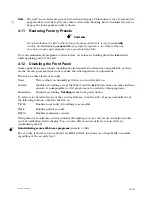
4-12
Rev 2.2, 10/31/94
element; in essence giving the compressor “time to think”. Edit buffer 67 controls the lookahead
delay time.
4.5.7.11 De-ess absolute threshold
The relative de-esser threshold can be accessed via the front panel. This threshold setting must
be relative in order that it not be sensitive to the overall signal level at any given instant in
time. The de-esser determines the relative amount of sibilant energy in the input signal which
is then compared to the low-frequency content of the input signal. The high-frequency content
must exceed the absolute threshold level. Once the signal exceeds the absolute threshold, the
sibilant energy content must then exceed the relative threshold setting. Only then will de-
essing occur. Edit buffer 22 controls the absolute threshold. Edit buffer 23 controls the relative
threshold and may be adjusted via the front panel, the realtime editor, or via MIDI.
4.6 Delay Group
The delay group encompasses a dual-delay line with cross-coupled feedback and delay-time
modulation. The delay time of each delay can be set independently, and the duAL mode
changes the delay times of both delays simultaneously while maintaining any
difference in the delay times. You can also add modulation to the delay
time(s). The modulation signal may be random, a sine wave, or a triangle
wave. The modulation signal depth (amplitude) and rate (frequency) are
adjustable. The delay group creates effects ranging from simple slapback
through small-room simulation, chorusing and flanging.
M
IX
Switch
Sets the
M
IX
ratio (%) between the direct and the
lowpass-filtered delayed signal. Holding down the
Mix switch (
rt
) allows editing the rate of change of
the mix gains. This parameter's rate-of-change is
shared with the
F
EEDBACK
switch.
D
ELAY
Switch
dL 1/dL 2/duAL
The two delay lines can be modified
either individually or in tandem. The display
indicates the delay time in milliseconds, and the
D
ELAY
switch toggles through the adjustment
modes. Adjustment in tandem (
duAL
) changes the
delay time of both delays simultaneously. This
mode maintains any difference in delay time
between the two delays. For monophonic delays,
set both delay lines to the same delay time prior to
entering
duAL
mode. In
duAL
mode, the display
indicates the delay time of delay number one.
Note: the delay-time increments used change
depending upon the current delay time. At short
increments, the change-increment is small (1 ms)
growing to 2 ms above 30ms, growing to 5 ms
above 100 ms. Above 310 milliseconds, the delay-
time increment is 10 ms. Thus, as you traverse the
range of delay settings, the increment between the
two delays changes according to the increment
used for that particular delay time. You can see the
actual setting of each delay by toggling the
D
ELAY
switch through
dL 1
and
dL 2
. Refer also to the delay
time table, found in Appendix C.
DEPTH
G
DELAY
DELAY(mS)
MIX
RATE
FILTER
)
FEEDBACK
MODULATION
Summary of Contents for 601
Page 46: ...4 18 Rev 2 2 10 31 94 This page is blank believe it or not ...
Page 48: ...4 20 Rev 2 2 10 31 94 Notes ...
Page 50: ...5 2 Rev 2 2 10 31 94 Notes ...
Page 70: ...7 16 Rev 2 2 10 31 94 Notes ...
Page 72: ...8 2 Rev 2 2 10 31 94 Notes ...
Page 74: ...9 2 Rev 2 2 10 31 94 Notes ...
Page 78: ...11 2 Rev 2 2 10 31 94 Notes ...
Page 126: ...D 12 Rev 2 2 10 31 94 Notes ...
Page 138: ...G 8 Rev 2 2 10 31 94 Notes ...
















































